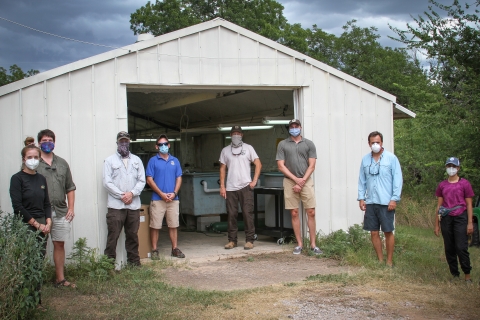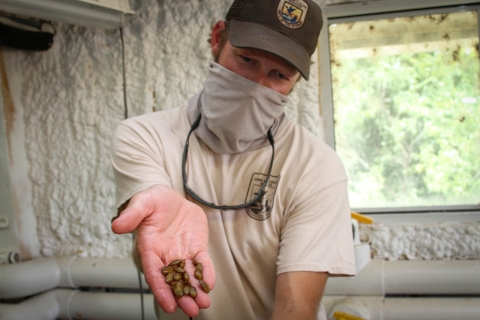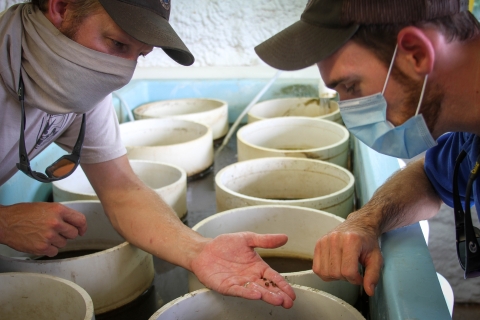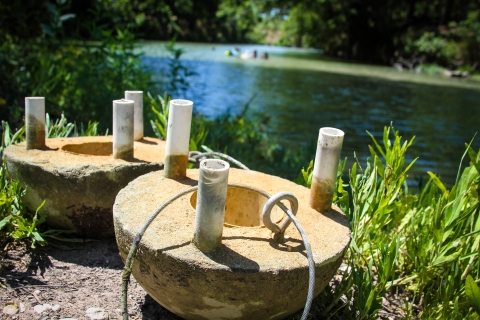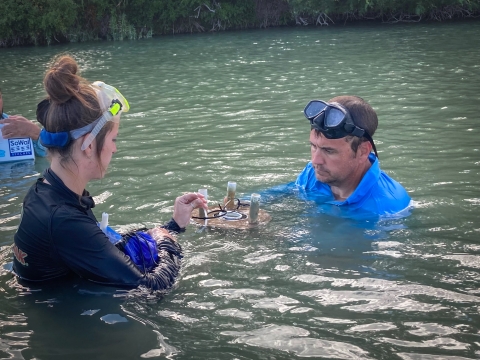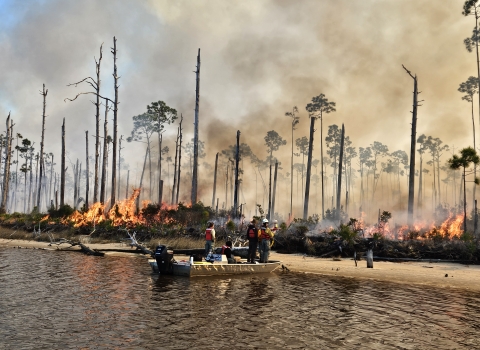Climate change includes both global warming driven by human-induced emissions of greenhouse gases and the resulting large-scale shifts in weather patterns. Though there have been previous periods of climatic change, since the mid-20th century humans have had an unprecedented impact on Earth's climate system and caused change on a global scale.
Learn more about climate change might exacerbate their struggle to survive.
Miles down an easy-to-miss dirt road just outside San Saba, Texas, a group of university, non-profit, state and federal researchers has converged on a remote stretch of the San Saba River. A biologist walking along the bank points out empty freshwater mussel shells with quirky names – pimpleback, pistolgrip, papershell – casualties of stranding during a time when the water ran too low. Pointing just a few yards downstream, he indicates a spot where one of their populations washed away completely during a time when the river ran too high.
He finds a few live mussels still hanging on just at the edge of the waterline, but this spot (like many on the river) is prone to extreme high and low flow events, leaving many of the mussel species that call it home in peril. Those who study Texas’ freshwater mussels worry these population impacts could be worsened in the future by climate change that is predicted to be severe in Central Texas.
“We anticipate with climate change, rivers are going to start going dry more, and they're going to have higher elevated temperatures, which can have effects on the lifecycle and long-term survival of some of these individuals,” said Matthew Johnson, Freshwater Mussel Conservation and Recovery Coordinator for the U.S. Fish and Wildlife Service (Service) in Texas.
The San Saba River is one of the last free-flowing river systems in Central Texas, beginning just west of Fort McKavett and meandering 140 miles through pecan groves, cattle ranches and hunting retreats before joining the Colorado River just above Lake Buchanan north of Austin. Though up to two-thirds of the river has dried out completely at times due to drought and excessive pumping, it still harbors viable populations of four critically imperiled mussel species currently under review by the Service for an Endangered Species Act listing: the Texas fatmucket, Texas pimpleback, Texas fawnsfoot and false spike.
A team of researchers from Texas A&M AgriLife Research and The Nature Conservancy are working on a project funded by the U.S. Fish and Wildlife Service’s Ecological Services and Science Applications programs to study how the extreme low and high flows that plague Texas rivers impact populations of these rare mussel species and how climate change might exacerbate their struggle to survive. By placing juvenile Texas fatmucket mussels into the San Saba River and monitoring their growth, they hope to explain changes in the distribution and abundance of both rare and common mussel species in these systems.
“The overall goal of this project is to look at whether or not flows in the San Saba are sufficient enough to support freshwater mussels,” said Dr. Charles Randklev, Research Scientist and Principal Investigator with the Texas A&M Natural Resources Institute. “What we hope to get out of this data is information that relates water temperature to discharge so that the U.S. Fish and Wildlife Service, the Texas Parks and Wildlife Department and The Nature Conservancy can engage local landowners and other groups within the basin to better manage both groundwater and surface water within the river.”
Randklev said finding juvenile mussels to use as test subjects is no easy task, particularly for a rare species like the Texas fatmucket.
“A big bottleneck for a lot of these studies is using juveniles, because that tends to be a more sensitive life stage for mussels,” Randklev said.
Luckily, not too far from where the San Saba River drains into the Highland Lakes, a team at Inks Dam National Fish Hatchery has been working on propagating the rare mussel species found in the San Saba and other Central Texas rivers. After several years of attempting to replicate the rare mussel’s complex reproductive needs in the hatchery setting, as of last year the team has developed state of the art techniques to do what no other hatchery in Texas has been able to do yet – produce Texas fatmuckets and other imperiled mussel species by the thousands.
Though the hatchery is producing mussels in significant numbers now, it wasn’t always so easy. The water pumped out of Inks Lake brings much-needed nutrients to the mussels, but early in the process researchers found that it also brings microscopic predators. Due to these predators, and fine substrate that can suffocate the mussels, none of the mussels produced in 2018 survived. Unwilling to give up, Inks Dam National Fish Hatchery Project Leader Jeff Conway turned to his staff to help solve the problem.
“After that, we went back to the drawing board and said ‘we’re gonna try everything this year,’” Conway said. “Bailey Gaines, a fisheries biologist here at the hatchery, built a lot of new systems here and put into place new filtration on the systems. Thanks to his and the rest of the team’s efforts, last year we produced hundreds of smooth pimpleback mussels, hundreds of Texas pimpleback mussels, and up to 5,000 Texas fatmucket mussels.”
The project was such a success that Gaines won the 2019 Innovator of the Year Award for the U.S. Fish and Wildlife Service’s Southwest Region for designing and engineering the new type of rearing system. With thousands more mussels produced so far this year, Conway is hopeful that now that they can produce mussels reliably and consistently, the project will benefit multiple researchers within the state and could one day aid stocking efforts if mussel species continue to decline in Central Texas rivers.
“We are trying to fill a need – mussels are the most endangered river animals there are, and they're dying everywhere,” Conway said. “We have a real chance to change the trajectory of freshwater mussels in Texas.”
Randklev’s team, the first to use Inks Dam’s hatchery-bred mussels for research in Texas, visited the hatchery in late July to collect hundreds of the juvenile Texas fatmuckets. After picking the dime-sized mussels out of the shallow dishes used to hold them during their early life stages, his team carefully measured and weighed each one before depositing them into small white cylinders made of plumbing pipe.
Once they reached their research sites on the river, the team donned diving gear and snorkels to secure the juvenile mussels in their new homes. After placing the white cylinders full of the mussels into helmet-shaped concrete mussel silos, they covered the ends with drain grates before zip-tying them shut and anchoring them with rebar under the water.
Amanda Goldsmith, a graduate student with the Texas A&M University Department of Wildlife and Fisheries Sciences, said the design for the mussel silos exploits the Bernoulli principle, which describes how changing the size or shape of a fluid’s flow changes its speed, and in turn, its pressure.
In other words, “The mussel silo is kind of like a little upwelling chamber, so it brings food and oxygen into where we put the mussels and carries the waste away,” Goldsmith said.
By taking advantage of this principle, researchers hope the mussels will have everything they need to survive until the team returns to measure and assess their growth. If they do, this data will provide key insights into how hydrologic changes in the river impact mussel persistence in the river.
“The main idea is that throughout those seven stages of the river, there's kind of a gradient of streams that are perennial and then go down to streams that are intermittent,” Goldsmith said. “When we come back in 30 days, hopefully more than that, we'll be able to re-measure the mussels and see how growth is affected by dewatering, as well as elevated water temperatures.”
Though the team found some live and some recently deceased mussels at each of the research sites, they also spotted signs of ancient mussel abundance and use by early Texans. At one of the mussel silo placement sites located near a county road crossing, researchers found a large number of discarded mussel shells in the riverbed, an indication it was a dumping ground from Native Americans who used them for food and tools. At another site located close to the town of San Saba, Randklev mentioned a nearby historic cemetery he saw that had graves adorned with freshwater mussel shells, an “old country” tradition brought to Texas by early European settlers.
Today’s Texans may not consider mussels to be staples of everyday life and culture like early citizens did, but they still serve an important purpose for modern human communities. In addition to filtering water and contaminants in Texas rivers, mussels help stabilize substrate and provide an important link in the food chain that benefits other aquatic life, including popular game species. For biologists, mussels also serve as a “canary in the coalmine,” sounding the alarm when the quality and quantity of water in rivers and streams are on the decline.
“Texas fatmuckets are more of a headwater species, so as we run into low flow conditions, it is probably one of the species that's going to be hit first,” Johnson said. “It's a canary in the coal mine to the canary in the coal mine, and to mussels as a whole. If we know that certain areas and certain rivers that are critical to mussel populations within the state are going to have additional stressors in the future, we're going to have to adapt our management plans to maybe start thinking outside of the box for how are we going to help these species kind of weather the storm.”
In an expansion of their ongoing hydrology research in the San Saba River watershed, staff from The Nature Conservancy in Texas are monitoring flows at the mussel silo sites and other locations prone to dewatering, in an effort to relate discharge to mussel growth and survivorship. The information collected will ultimately help provide management advice for defining flow targets and informing collaborative flow restoration strategies in the San Saba River.
“What we're really trying to do is better understand how the basin is functioning,” said Ryan Smith, Freshwater Ecologist with The Nature Conservancy in Texas. “The groundwater goes in and out in multiple places, to and from different aquifers—some of that's well understood, and some of it isn’t. We've been gathering both groundwater and surface water data to fill the gaps in understanding around how the water moves through the system.”
Kyle Garmany, Water & Agriculture Program Director with The Nature Conservancy in Texas, said although there have been studies on the river dating back to the early 1900s, few recent studies have attempted to characterize the hydrology of the system, including trying to understand the contributions of groundwater to overall surface water flows.
“We’ve seen significant droughts over the past decade in this system and have more frequently heard questions like ‘Why does the river look the way that it does?’ Or ‘why does the river run dry?’” Garmany said. “Ultimately, we want the resource managers, the landowners, and the folks up and down the river to have an understanding of the system that will allow them to make decisions that are based on fact and an objective view of the system itself. And what we’re doing is providing the data necessary to inform those decisions.”
Though this particular project focuses on the four mussel species under review for an Endangered Species Act listing, the mussels are not the only ones who rely on a healthy river. Garmany said The Nature Conservancy’s work on the San Saba River is also geared toward bringing solutions to the table for the people who rely on the river continuing to flow, which includes bringing forward environmental market-based strategies and innovative solutions that incentivize water conservation and offset economic impacts for landowners.
“This is a soup to nuts approach to river conservation,” Garmany said. “We're letting the science lead, we're engaging stakeholders, and we're bringing forward solutions that are going to protect and restore flows for the benefit of the species that rely on it, but also for the benefit of those who live and work along the river.”
The results of the project will also extend even farther out of the immediate community to the entire Colorado River watershed. A U.S. Geological Survey South Central Climate Adaptation Science Center companion study is determining how often precipitation whiplashes and boomerangs occur in the Colorado Watershed, including the San Saba River, and to what extent their frequency and intensity could change in the future and how that might impact mussels.
“Even though the silos are only focusing on the Texas fatmucket, it is part of a larger climate change study which is going to create a regional scale model for how Hill Country rivers in general are going to look in the future regarding flow changes and temperature changes,” Johnson said. “We can use this information to decide how we want to manage these issues, whether that is working in improving habitat, trying to identify certain habitat characteristics or risk factors that we have a potential to mitigate, or maybe looking into doing restoration and augmentation work in the future, which is something that the hatchery system would help out with if we if we decide that it is something worth pursuing.”
Johnson, who was hired on as the Service’s new Freshwater Mussel Conservation and Recovery Coordinator in Texas in early 2020, said though other states have been studying mussels for decades, he is excited to see efforts to understand and conserve imperiled freshwater mussels ramping up in Texas.
“For the longest time Texas was the Wild West…there wasn't really a lot of emphasis on working on mussel issues,” Johnson said. “So it's nice that that some of these projects are starting to get up and running. And we can we can look towards those projects that were done in other places and say, ‘Hey, this had a really good result. We can see that these same principles apply, and here are the management strategies or risk factors that had been observed in other parts of the country that also apply here.’ So in that way, it's kind of nice being a little behind.”



